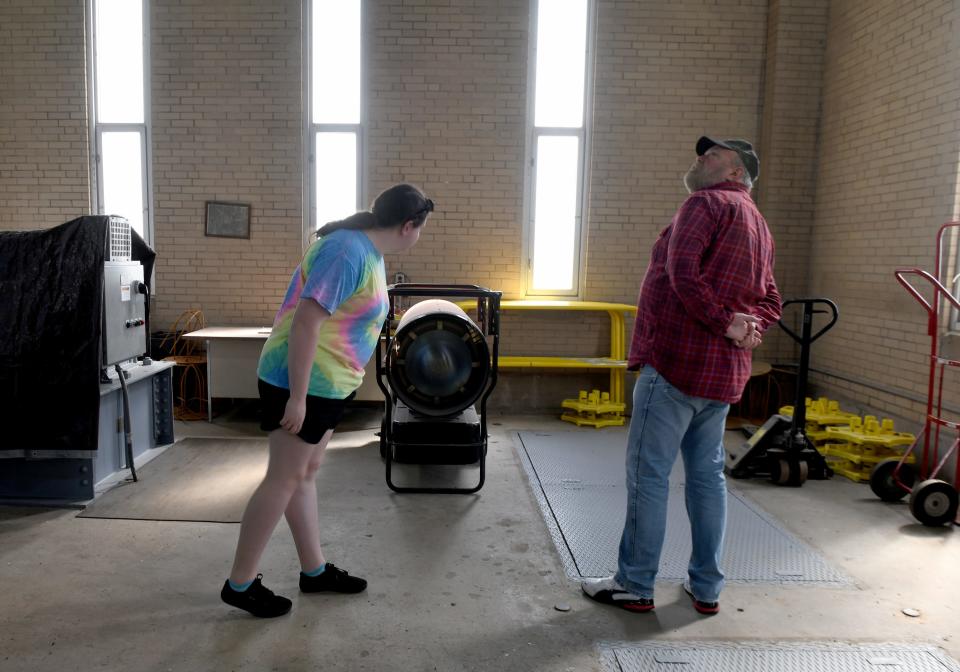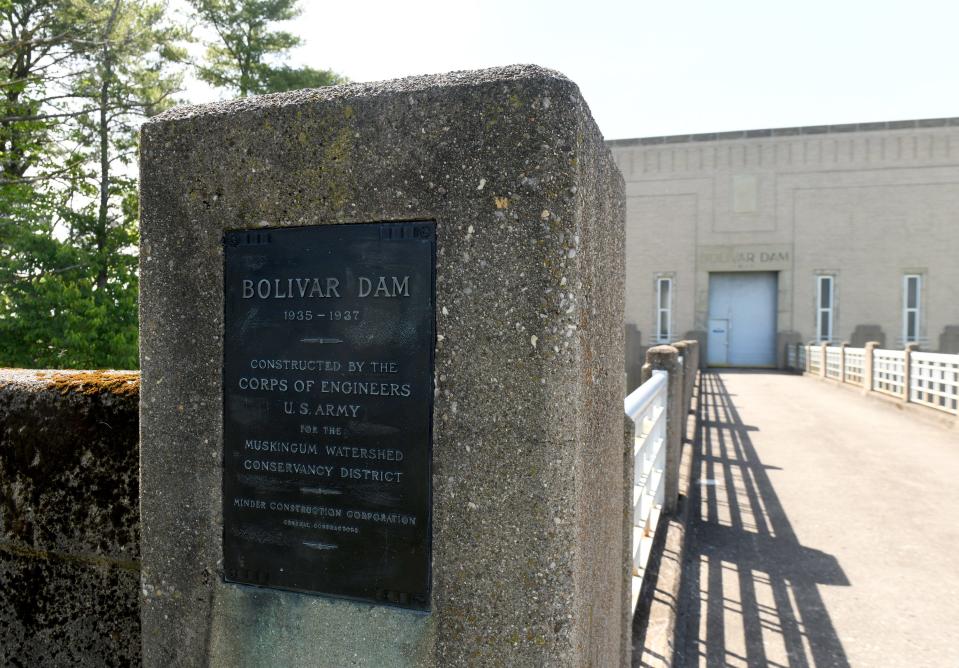The doors to the dam gatehouses operated by the U.S. Army Corps of Engineers are usually locked and secured behind “No Trespassing” signs.
But in Saturday from 10 a.m. to 2 p.m., the doors to the gatehouses of seven dams in four nearby counties were open. The dams were Dover, Bolivar and Atwood dams in Tuscarawas County; Clendening and Tappan dams in Harrison County; Leesville Dam in Carroll County and Pleasant Hill Dam in Ashland County.
Members of the public were permitted to go in. They could explore the rooms where the Army Corps’ dam tenders operate the motors that control the gates of the dam. And they could speak with the dam tenders, whose job it is to manage the flow of creeks and rivers during a flood to prevent significant damage downstream.
National Dam Safety Day
Related: Huff Run tour to include visit to Dover Dam
The Muskingum Watershed Conservancy District, which has about 14 dams, and the U.S. Army Corps of Engineers organized the dam open houses as part of National Dam Safety Day, which was Friday. But the doors to the gatehouses were open Saturday because organizers thought they’d get more turnout during the weekend, said Ethan Zucal, a spokesman for the conservancy district.
Zucal himself and his family were among the steady stream of visitors Saturday to the Dover Dam on state Route 800 in Fairfield Township in Tuscarawas County, northeast of Dover and New Philadelphia.
The dam, built in 1935 to control the flow of the Tuscarawas River into Dover, New Philadelphia and communities downriver, is the only concrete dam in the conservancy district.
Visitors for four hours were permitted to climb down a spiraling staircase with 72 steps into the lower level within the concrete structure. They could see the equipment that pushes down a maximum of 18 gates to significantly reduce the flow of the Tuscarawas River in a flood event.
Josh Raber, one of the three dam tenders for the Dover Dam, recounted higher Ohio River levels in early April in Marietta prompted the Corps to shut down nearly all of the dam’s gates to try to relieve the rising water levels downstream. But the Dover Dam also had to maintain a minimum level of flow to cool the Dover Light and Power plant on the Tuscarawas River, and to ensure oxygen levels downriver were sufficient to sustain fish.

U.S. Geological Survey water gauges at creeks upstream, such as on the Nimishillen Creek in Stark County, serve as an early warning system. If the water rises to flood levels, U.S. Army Corps staff have to be at the dams in the watershed around the clock. By lowering gates by a certain amount to control the size of the openings the water can flow through, they adjust the amount of water going through communities downriver.
Six of the gates can be controlled remotely. But 12 of the gates can only be controlled with manual controls from the dam’s lower level, said Raber, a civilian employee of the Army Corps since 2018.
“Minor changes in gate setting can result in major effects downstream,” said Raber, who said the effects of lowering the dam gates to adjust river flow will be felt in Dover in an hour and in New Philadelphia in about four hours.
Further complicating the decisions of how much to adjust the gate settings, debris such as trees accumulates behind the dam during floods, changing the flow of the river.
The goal is to prevent a catastrophic flood that could take lives and wipe people, homes and towns away. The federal government working with the conservancy district built much of the area’s dam and levee systems in response to the big flood of 1913 that killed at least 467 people in Ohio.
In Dover Dam’s 89 years, the Tuscarawas River has never risen to the point that water was pouring over the dam, which has a spillway 916 feet above sea level. The highest it’s ever gotten was 905 feet above sea level during a 1969 flood, Raber said.

Among the visitors, Braiden and Brianna Rennicker of Sherrodsville, after walking through the dam’s lower level, were on the higher level checking out the Dover Dam with their 5-year-old son James.
Calling the dam “really impressive,” Braiden Rennicker explained to his son how water from Leeville Lake and Atwood Lake fed into the Tuscarawas River. And when a lot of rain falls, “they try to stop (the water) so we don’t flood Dover and keep everyone safe.”
Brianna Rennicker said, “I think it’s awesome. It’s nice to see how it works down here.”

Bolivar Dam
Related: Bolivar Dam repairs running a little ahead of schedule
About 8 miles away, a constant stream of visitors were stopping at the gatehouse of the Bolivar Dam in Lawrence Township in Tuscarawas County. The earthen dam, with a paved road on top, controls with six gates the flow of the Sandy Creek from Stark County to the Tuscarawas River. The dam, built in 1935, is east of Bolivar near State Route 212 by the county boundary with Stark County.
The open gatehouse window provided a beautiful view 100 feet above Sandy Creek as it entered the dam from the southeast along a meandering course northwest to meet the Tuscarawas River. Children by the creek’s banks were throwing rocks into the water. However, the stairs were so steep that to prevent any injuries, the Army Corps decided to keep the stairs closed.
Some of the visitors had backgrounds in engineering and mechanical equipment. They were curious how the gates functioned.
Doug Carpenter, an engineer, and his daughter Katie Carpenter, an engineering technician for the Canton Health Department, were trying to visit all seven dams in four hours.
David Palkey of Jackson Township, a mechanical engineer, said: “It’s fascinating to see its structure. … It’s cool to see the machinery.”
Heather Rowe of Wilkshire Hills came by with her 7-year-old son Reece and 4-year-old daughter Caroline.
“I thought this would be something cool because they don’t open this all that often,” Rowe said. “I never understood how interconnected how everything is. … You take it for granted. We’re going by it (the dam) every single day.”
Matt Calder, one of the two dam tenders for Bolivar Dam, said the gates are operated by electrical motors that rely on the normal power grid. But the gatehouse does have a backup generator. And if necessary, the gates can be manually lowered without power. He said the equipment has regular inspections and an intense inspection every five years, including of the tunnels underneath the dam. The Corps has to regularly clear debris from the dam and waterways.
Calder said if water at Dover Dam rises to 20 feet above its base, then the Bolivar Dam closes its gates to allow waters downstream to subside. He said that took place in early April. But normally the six gates are open and allow for a 2 1/2-foot opening for the waters of the creek to go through.
Calder said the dam’s base is at 895 feet above sea level. The record crest of flood water was 951 feet above sea level during a flood in 2005. That’s about 56 feet higher than the base. Markers on the side of a wall measure over 85 feet above the base, in case the dam ever encounters a truly catastrophic flood.

Reach Robert at robert.wang@cantonrep.com. X formerly Twitter: @rwangREP.
This article originally appeared on The Repository: Muskingum Watershed dams open to public for National Dam Safety Day
Signup bonus from





